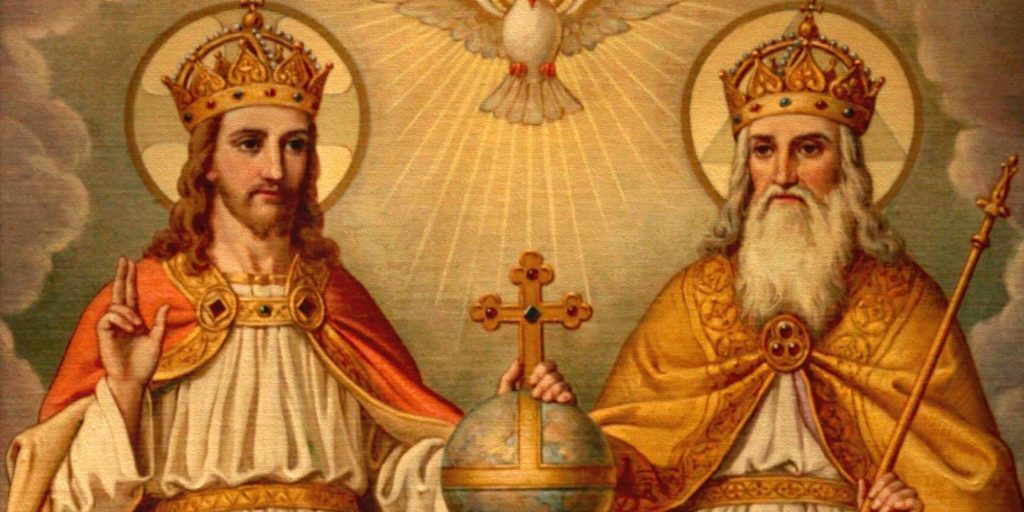
The Location of the Risen and Ascended Christ and Biblical Theology
In Colossians 3:1-2 Paul exhorts his readers to ‘seek’ and ‘set’ their minds on ‘the things that are above, where Christ is, seated at the right hand of God’ (ESV). To think, in other words, about the risen and ascended Christ. However, it is probably fair to say that most Christians tend to think more about the cross, resurrection or return of Christ rather than Christ as he is in his exalted state. Further, considering the nature of the exalted Christ may seem to be a subject more obviously suited to systematic theology rather than biblical theology. However, apart from the ongoing need to show the interconnectedness of these two disciplines, considering the temporal structure of the Bible’s revelation helps us to see the relevance of this topic to biblical theology.[1]
There are as many proposed ‘structures’ of the Bible as there are biblical theologians. Graeme Goldsworthy, building on the earlier work of Donald Robinson and Gabriel Hebert, has popularized the schema that is now associated with Moore College.[2] He argues that the organizing principle of the Bible is the ‘kingdom of God’, and divides the Bible into four main epochs, which each provides development in the revelation of the kingdom of God: the kingdom of God revealed in Israel’s prehistory (Gen. 1 – 11);[3] the kingdom of God revealed in Israel’s history (Abraham to Solomon); the kingdom of God revealed in prophetic eschatology (Solomon to the end of exile); and the kingdom of God revealed in Jesus Christ (the NT).
Goldsworthy further subdivides this final epoch into three aspects:[4]
(1) What Jesus did for us in the past, historical gospel event in fulfillment of the promises of the Old Testament.
(2) What the word of Jesus and his Spirit go on doing in us as we live in the present our life of faith and in the world as the gospel is proclaimed.
(3) What the end-time consummation with us will be when Jesus returns in glory to judge the living and the dead and to bring in the fullness of his kingdom.
Whether or not we accept Goldsworthy’s overall structure, this delineation of the New Testament era helpfully distinguishes the different aspects of Christ’s work for us. However, in this schema there is a subtle tendency to downplay the ongoing significance of Jesus. Whereas in points 1 and 3 Jesus is presented actively (‘what Jesus did for us’ and ‘Jesus returns’), in point 2 the Spirit and Jesus’ ‘word’ are presented as the active agents.
Undoubtedly the NT affirms the work of the Spirit (e.g. Rom. 8:14) and the power of Jesus’ word (e.g. Acts 6:7); however, it also affirms that Jesus himself remains active. For example, he intercedes (Rom. 8:34; Heb. 7:25), he enables Christians to persevere (Rom. 14:4; 1 Cor. 1:7–8) and he continues to speak through his apostles (2 Cor. 13:3). Yes, the focus of the NT is on the past (and future) work of Christ but it is by no means silent on his present work.
Further, Goldsworthy’s scheme implies that this is a period of Christ’s absence. However, the picture across the New Testament is more complicated than simply saying that Jesus leaves and the Spirit comes. For a start, what are we to make of Jesus’ famous promise in the great commission, ‘Behold I am with you always, to the very end of the age’ (Matt. 28:20; ESV)? According to this verse, this age is fundamentally the age of the presence of Jesus. Again, as he concludes his high-priestly prayer in John 17, Jesus expresses the desire that the love the Father has for him may be in the disciples, and that he himself ‘may be in them’ (17:26). Even though Jesus is leaving and sending the Spirit, he himself will ‘be in them’.
However, in the same prayer Jesus affirms that he is ‘no longer in the world’ even while believers ‘are in the world’ (17:11). There appears, then, to be something of a tension between the absence and presence of Christ. So, in 2 Corinthians, Paul can state that ‘while we are at home in the body we are away from the Lord’ (2 Cor. 5:6; cf. 5:8 ESV) and he can remind the Corinthians in the same letter that Christ ‘is powerful among you’ (13:3). One of the questions we are left with when we think about the exalted Christ is what is the relationship between his absence and his presence? If anything, in theological reflection on this question, there is an emphasis on the ongoing presence of Christ. For example, Beverly Gaventa suggests that ‘Jesus’ ascension does not mean his absence; it simply means that his presence is no longer constrained by place and time’.[5] However, these kinds of suggestions overlook important strands of NT data which indicate that Christ’s absence is more Christologically significant.
Perhaps the relationship between Christ’s absence and presence can be best understood in a form similar to what Paul says about himself in 1 Corinthians 5:3. In this chapter, Paul is appalled at the behaviour of the Corinthians. They are not only tolerating the behaviour of a man in their congregation who is sleeping with his stepmother, but simultaneously they have a high view of their own spiritual status. Paul is not going to sit back and do nothing. The problem is that he is in Ephesus, about 1000 miles from Corinth. However, this absence does not prevent him from acting: “For though absent in body, I am present in spirit; and as present,[6] I have already pronounced judgment on the one who did such a thing” (ESV adjusted; v. 3).
Though unpacking how Paul understands his own location may raise its own questions, I think this is a helpful way of thinking of Jesus’ presence and absence. (In fact, it may be that Paul’s view of his own presence and absence is modeled, in some sense, on that of Jesus.)
Christ is absent in body
The ascended Christ remains a human being with a body (albeit an exalted one) which means that like any other human being, his location is fixed. He is not everywhere. This comes out in chapter 3 of Philippians. Here Paul reminds his readers that their ‘citizenship is in heaven, and from it [their] await a Saviour, the Lord Jesus Christ, who will transform [their] lowly body to be like his glorious body’ (vv.20-21). Jesus remains a human being and he retains a human body. It is this body that explains his absence from us.
Christ is present through the Spirit
Romans 8 helps us to understand how Christ is present through the Spirit. Paul starts the chapter by spelling out the differences between walking in the Spirit and walking in the flesh – one leads to life and the other death. In Romans 8:9-11 Paul then reminds his readers that the Christian is someone who is in the Spirit and in whom the Spirit dwells. Paul describes the Spirit as the Spirit of God and the Spirit of Christ (v.9). Then in verse 10, it is not just the Spirit who is in the believer but Christ himself. But by verse 11, Paul has reverted to saying that it is the Spirit who dwells in them. So, the Spirit can be described as the Spirit, the Spirit of God and the Spirit of Christ. And as well as the Spirit living in us, Christ himself is in us.
Paul switches between the Spirit and Christ – because if the Spirit is dwelling in you, then Christ is in you. We get a very similar thought in John 14. Here as Jesus teaches the disciples before his departure he promises them that he will send the Spirit to them (14:16-17). But he immediately interprets this to mean that he himself will come to him (14:18). The Spirit coming means that in some sense Jesus too comes to them.
In other words, the Spirit is not just a representative or a substitute for the absent Jesus. Where the Spirit is, there is the Father and the Son. The Spirit does not just represent Jesus. Rather, because of the nature of their relationship, he actually brings Jesus with him. Because of the work of the Spirit, Jesus really is with us. If you are a Christian, he really is in you.
Conclusion
In this post we have just touched on one aspect of the exalted Christ – namely his location, and the relationship between his absence and presence. Both are important and both help us understand important features of Christ in his exalted state. There are obviously other aspects of his exalted state that we could examine. Further, my argument above has shown that the boundaries between Biblical Theology and Systematic theology become somewhat porous – but that is no bad thing if we are concerned to correctly set our minds on ‘the things that are above, where Christ is, seated at the right hand of God’!
Endnotes
[1] Parts of this article appear in a slightly different form in Peter Orr, Exalted Above the Heavens: The Risen and Ascended Christ (NSBT: Leicester: IVP, 2018), 1-4.
[2] See Graeme Goldsworthy, Christ-Centred Biblical Theology: Hermeneutical Foundations and Principles (Nottingham: Apollos, 2012), 24–27.
[3] Strictly speaking this is not an ‘epoch’ in Goldsworthy’s schema.
[4] The text here is taken verbatim from Graeme Goldsworthy, The Son of God and the New Creation (Short Studies in Biblical Theology; Wheaton: Crossway, 2015), 26.
[5] Beverly R. Gaventa, ‘Learning and Relearning the Identity of Jesus from Luke-Acts’ in Seeking the Identity of Jesus: A Pilgrimage (ed. B.R. Gaventa and R.B. Hayes; Grand Rapids: Eerdmans, 2008, 163.
[6] The ESV is unhelpful here. It translates this “as if present”, but the Greek simply says “as present”.

